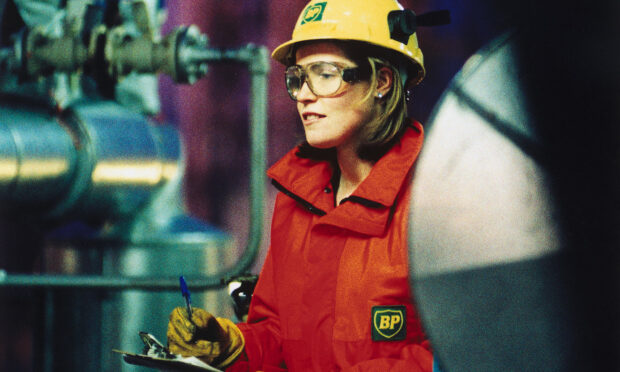UK energy firms are paying men around 20.2% more than women on average, according to a new study of the sector’s gender pay gap.
Law firm Pinsent Masons has shed new light on the issue, with analysis of the median gender pay gap for the industry.
The research looked at publicly-filed pay information across 97 employers in the sector in 2021, with a shortage of women working in STEM sectors being a major underlying cause.
All data gathered relates to organisations operating in the UK.
Despite the disparity, the figures show a year-on-year improvement for the GPG since 2017, with several firms reporting improvements of up to 5%.
One underlying cause of GPG is the shortage of women working in the STEM sectors, Pinsent Masons said.
Women only make up around 1.8% of the offshore energy sector workforce, as Wood’s Sarah Clark recently reported.
Senior associate and employment law specialist at Pinsent Masons, Lisa Byars, said: “Job-specific factors are also relevant to the cause of the pay gap, particularly where more men are typically earning additional call out and unsocial hour allowances compared to women.
“This is particularly the case within oil and gas, where offshore workers earn offshore allowances, travel allowances and other additional payments to reflect the rotational working pattern.”
Ms Clark added that, to achieve improvement, firms need to actively promote family-friendly policies including hybrid working and paid family leave, regardless of gender, and support on maternity leave.
“A business’ approach towards diversity and inclusion is an increasing differentiator in the battle to recruit and retain talent,” she added.
Service companies and the gender pay gap
The Aberdeen-based oil services company Archer has been found to have a median gender pay gap of 52.3%.
That means that on average for every pound a man makes at the company a woman makes 48p.
In the organisation, women make up 3.9% of the positions in the upper hourly pay quarter (the highest paid roles).
As for other service companies:
- Female Petrofac employees on average earn 63p for every pound a male worker makes.
When asked about this Petrofac responded: “The energy services sector has historically employed a significantly higher number of men than women in technical occupations and senior roles, where the average hourly pay is typically higher, and this is still reflected in the makeup of our workforce.
“This industry-wide issue does not have a short-term solution, which is why encouraging more women into STEM careers, building up a pipeline of female talent and identifying future leaders is a long-term priority for our business.
“We’ve set a target of 30% of women in senior roles by 2025, and we are on track to achieve it.”
- Aberdeen-owned and operated Wood pay women 35p less than men on average (65p for every £1 a man earns).
Wood also made comment on its figures, saying: “Men fulfil more technical and engineering roles, which are typically higher paying than functional roles traditionally fulfilled by women.
“Our gender pay gap is therefore explainable, though not acceptable as a status-quo.
“We have been laser focused on addressing this in recent years and have clear actions underway to ensure we are building a sustainable, equitable and diverse team at Wood”
- Women at Baker Hughes earn 88p for every pound a man makes on average.
Of the major service providers, Schlumberger pays women most equally on average, although this firm still has no pay equality.
Female employees at the service company earn 90p for every £1 a man takes home, on average.
21% of those in the highest earning quarter of positions are women and 87.4% of women received bonus pay (91% of men received bonuses).
The oil operators
Of the oil companies reviewed, London-listed Harbour Energy fared the worst.
With an average gender pay gap of 40p, women at the company earn a median of 40.4% less than men (this means that women make 60p for every pound a male worker).
Women at the company make up 7.5% of the top 25% of highest-earning roles and are 2.6% less likely to receive a bonus.
Harbour Energy said: “Having a greater number of men in senior positions or in technical roles with a higher level of pay will mean a greater average pay for men than for women.
“Harbour Energy is dedicated to addressing this imbalance and to improving our workforce demographics in the long term.
“Supporting the advancement of women is paramount for us to succeed as a company, especially in our industry that is two-thirds male.”
As for the European oil majors:
- Total Energies reported that the median hourly pay of its female employees is 28.4% lower than men’s (earning 72p for every £1 a man takes home).
- Shell UK’s female employees earn 83p for every pound a man makes on average, however, men and women are equally as likely to receive a bonus at the company (25.3%).
Shell explained these figures, saying: “For 2021, our average gender pay gap was 17.8%, an improvement from 18.0% in 2020 and 18.7% in 2019.
“Compared with 2020, we also saw a continued upward trend in the proportion of women in our upper pay quartile.
“Whilst men and women are paid the same salary for equivalent work, Shell in the UK does still have a gender pay gap.
“Some of the reasons are that there are currently more men than women in senior positions and women are under-represented in some technical roles.
“We strive to increase representation of women at senior levels and in other parts of our businesses where women are under-represented.
“We are strengthening our policies and practices and focusing on our approach to recruitment and development in business areas where we face the greatest challenges. Shell in the UK will continue to hire, retain, and promote people based on merit.
“By removing barriers, widening our recruitment to attract diverse candidates, and supporting and developing employees, each of our businesses in the UK will continue to work towards achieving gender balance.”
- UK oil giant BP pay women 15p per hour less than men on average and only 5.2% of female employees can expect a bonus, however, if a woman does receive a bonus they can expect £1.47 for every £1 a man receives.
Overall, the energy sector is improving with regards to even pay, that being said, equality is still a ways off for women working in oil and gas.
Chair of POWERful Women and executive vice president at Shell Katie Jackson said:
“One significant factor in the gender pay gap is a persistent lack of women in managerial and senior leadership roles.
“So closing the gap means doing more to harness the huge amount of female talent available to the energy sector, recruiting and cultivating women into the leadership pipeline and achieving better balance at the top tables.
“It’s disappointing that in 2022, three-quarters of the top 80 energy companies in the UK still have no women in executive director roles and our data shows that women currently make up under a third of the executive pipeline.
“But I’m pleased that many of the major energy companies are showing positive commitments to improve gender diversity and we are working to support faster, better progress in the sector.”
All the companies mentioned throughout were asked for comment on the numbers presented.



Conversation